I decided to tackle the repair of my beautiful Blueberry Clamshell iBook which just keeps getting darker and darker as the years go by...
The backlight has been getting notably worse each time I boot it up. Over a year ago, I bought a backup "spares" Blueberry clamshell with the intention to eventually take the backlight out of it and install into my prize Blueberry. I pulled it out today to take a look, but had a change of heart and decided to instead salvage a CCFL tube from a cracked 12" PowerBook G4 display, which was otherwise destined for the trash.
I started by taking a look on iFixit for a guide to remove the LCD and came across a simple guide for removing the front bezel. I then went freestyle from there...
![DSC_0033.jpg DSC_0033.jpg]()
1. After removing the rear cover at the handle, also take the four PH1 screws holding the display rear in place.
![DSC_0034.jpg DSC_0034.jpg]()
2. Including these two.
![DSC_0118.jpg DSC_0118.jpg]()
3. Once the front bezel is removed, take out four PH1 screws holding the housing along the top and then the four screws holding the LCD panel in place. The panel then lifts forward and the inverter power connector and LVDS cables can be easily disconnected. Here is the inner frame with the LCD panel completely removed.
![DSC_0119.jpg DSC_0119.jpg]()
4. Here I've connected the original LCD panel to the backlight inverter and powered it on. The display is so dim it's hardly visible (with the camera flash on).
![DSC_0121.jpg DSC_0121.jpg]()
5. I then connected the broken PowerBook G4 12" panel to the backlight inverter and can see the backlight come on fine when I power on the iBook. I actually tested 3 different cracked 12" panels which I had on hand (2 from iBook G4s and one from the PBG4 12"). The PBG4 12" display was the winner in terms of backlight quality.
![DSC_0123.jpg DSC_0123.jpg]()
6. The first thing was to remove the backlight from the donor LCD Panel. 7 little PH000 screws from the rear and sides of the panel are removed to then gently lift and peel out the CCFL tube. Here I've connected the backlight tube directly to the inverter board and powered on the iBook to test the backlight is still working after being removed from the existing panel. The flash has drowned out the brightness of the tube here.. it's actually really bright.
![DSC_0124.jpg DSC_0124.jpg]()
7. Here I have the original Clamshell CCFL tube above and the PBG4 12" tube below, both still in their reflective channels.
![DSC_0125.jpg DSC_0125.jpg]()
8. Lining them up I can see the original tube looks slightly thicker (maybe 2.5mm?) whereas the replacement is 2mm thick.
![DSC_0128.jpg DSC_0128.jpg]()
9. I did a bit of a "dry run" by dismantling the 'spares' iBook I mentioned earlier just to get an idea of what is involved. So here I hook up the two CCFL tubes side by side after carefully removing them from their reflective channels. It's impossible to tell here, but the original is the one on the right and the replacement is on the left. They both look bright in the photo, but the different was quite obvious in the flesh.
![DSC_0129.jpg DSC_0129.jpg]()
10. Here they are side by side. The top is the thicker, original tube.
![DSC_0133.jpg DSC_0133.jpg]()
11. Now this is where things get a bit questionable.. The original, thicker tube is about 4mm longer than the PBG4 12" tube. Is it going to work?
![DSC_0134.jpg DSC_0134.jpg]()
12. I decided to continue on anyway. The first step was to re-solder the connection of the white wire here so that it is straight on instead of being at a 90 degree angle. This will mean I can make up the difference in length by re-positioning the rubber end-caps.
![DSC_0135.jpg DSC_0135.jpg]()
13. A quick test of the backlight after re-soldering and re-fitting the end caps. Looks good.
![DSC_0136.jpg DSC_0136.jpg]()
14. Here I've installed the thinner 2mm PBG4 12" CCFL tube into the original Clamshell reflective channel and positioned the black wire to run back along the channel in the white clips.
![DSC_0137.jpg DSC_0137.jpg]()
16. I've guided the black wire all the way along the channel, now out the other end (where the white cable and inverter plug are).
![DSC_0138.jpg DSC_0138.jpg]()
17. Here we are at the plug-end. I've re-attached the right-angle rubber end-cap here. I found it simpler to slice through this rubber cap to remove it from the original tube instead of removing the existing solder and re-soldering it back together. Once it is back together the cut along the rubber cap won't make a difference.
![DSC_0139.jpg DSC_0139.jpg]()
18. Now this is where a whole lot of patience and a little finesse came into play. I had to carefully position the shorter CCFL tube within the channel millimeter by millimeter until I had the ends barely visible. As with all fluorescent, the ends are never as bright as the rest of the tube.
![DSC_0141.jpg DSC_0141.jpg]()
19. I've positioned the black wire end of the tube to be precisely within the end-caps. You can see the darkening of the CCFL tube which usually happens over time creeping into the corner.
![DSC_0142.jpg DSC_0142.jpg]()
20. I then installed the tube and reflective channel into the LCD panel. Initially it wouldn't sit very flush, so I seated things down with some Kapton tape here. The high-temps shouldn't affect the tape.
![DSC_0143.jpg DSC_0143.jpg]()
21. Here is the black-wire end after applying the tape. The original copper tape running along the top, which acts as a seal would not re-stick so I just taped it down from above. At this point I should mention that unlike EVERY other LCD panel I have worked on, the Clamshell has a backlight running along the top of the panel, instead of the bottom.
![DSC_0144.jpg DSC_0144.jpg]()
22. Here is a bit of a hack. Because the replacement tube had a shorter inverter cable, I had to re-wire the inverter plug behind the display housing instead of running in a channel down the right of the panel. Not sure if this is going to fit back together yet, but we will see...
![DSC_0146.jpg DSC_0146.jpg]()
23. After fitting the CCFL tube I powered it up and the results are a bit disappointing...
![DSC_0147.jpg DSC_0147.jpg]()
24. The top is super bright and the rest is dull as before...
![DSC_0148.jpg DSC_0148.jpg]()
25. Yep, that is not going to cut it. Let's pull it all apart and do it all again. That initial resistance which I experienced from the channel when seated on top of the panel was because something was out of alignment. My guess is the reflective channel is facing forward by a few degrees instead of sitting perfectly flush with the panel.
![DSC_0149.jpg DSC_0149.jpg]()
26. After disassembling the panel again, re-seating the backlight channel and re-assembling, the results are significantly better. I know, I can see some highlights in the photo here, but the difference is night and day.
![DSC_0145.jpg DSC_0145.jpg]()
27. So, I began re-assembling the rear panel and front bezel... After getting it back together I noticed the rear housing felt loose, so I unclipped the plastic bezel and went at it again. I discovered that I had not hooked these plastic tabs in-front of the steel inner chassis so the 4 screws running along the top of the display were not connecting with anything.. Here I've hooked the plastic in front of the frame as it should be
![DSC_0152.jpg DSC_0152.jpg]()
28. We are all back together now, so I boot it up. Looking good.
![DSC_0153.jpg DSC_0153.jpg]()
29. Gorgeous! We have full brightness and contrast, with just a minor darkness in the top right corner. This would be due to the slightly shorter length CCFL tube, but is certainly 1000% better than it was.
Overall I'd give the repair a 9 / 10. It cost me nothing and has restored the Clamshell display back to full brightness. I have no idea just how many hours that replacement tube would have had on it, but at least I now know that it is possible to replace the CCFL tube in the Clamshell with a 12-inch iBook G3, iBook G4 or PowerBook G4. It is not only possible, but relatively easy.
Success!
-AphoticD



The backlight has been getting notably worse each time I boot it up. Over a year ago, I bought a backup "spares" Blueberry clamshell with the intention to eventually take the backlight out of it and install into my prize Blueberry. I pulled it out today to take a look, but had a change of heart and decided to instead salvage a CCFL tube from a cracked 12" PowerBook G4 display, which was otherwise destined for the trash.
I started by taking a look on iFixit for a guide to remove the LCD and came across a simple guide for removing the front bezel. I then went freestyle from there...
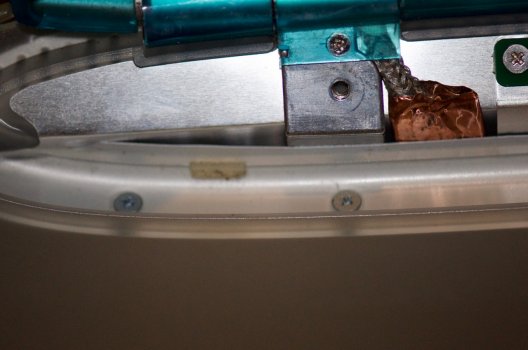
1. After removing the rear cover at the handle, also take the four PH1 screws holding the display rear in place.

2. Including these two.

3. Once the front bezel is removed, take out four PH1 screws holding the housing along the top and then the four screws holding the LCD panel in place. The panel then lifts forward and the inverter power connector and LVDS cables can be easily disconnected. Here is the inner frame with the LCD panel completely removed.

4. Here I've connected the original LCD panel to the backlight inverter and powered it on. The display is so dim it's hardly visible (with the camera flash on).
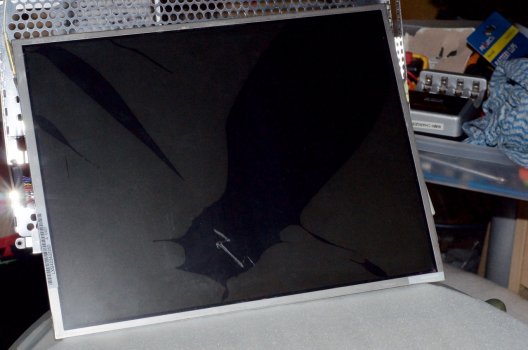
5. I then connected the broken PowerBook G4 12" panel to the backlight inverter and can see the backlight come on fine when I power on the iBook. I actually tested 3 different cracked 12" panels which I had on hand (2 from iBook G4s and one from the PBG4 12"). The PBG4 12" display was the winner in terms of backlight quality.
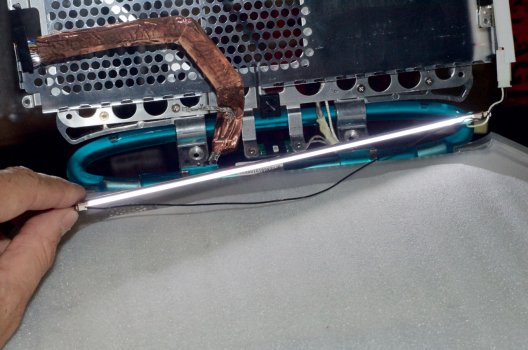
6. The first thing was to remove the backlight from the donor LCD Panel. 7 little PH000 screws from the rear and sides of the panel are removed to then gently lift and peel out the CCFL tube. Here I've connected the backlight tube directly to the inverter board and powered on the iBook to test the backlight is still working after being removed from the existing panel. The flash has drowned out the brightness of the tube here.. it's actually really bright.
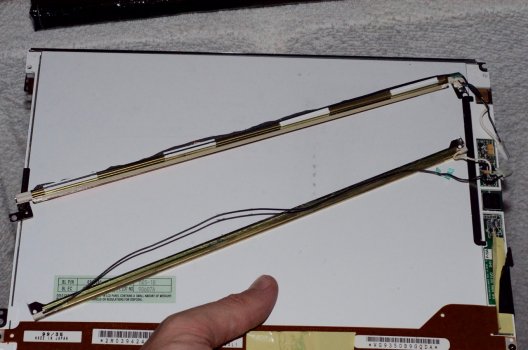
7. Here I have the original Clamshell CCFL tube above and the PBG4 12" tube below, both still in their reflective channels.
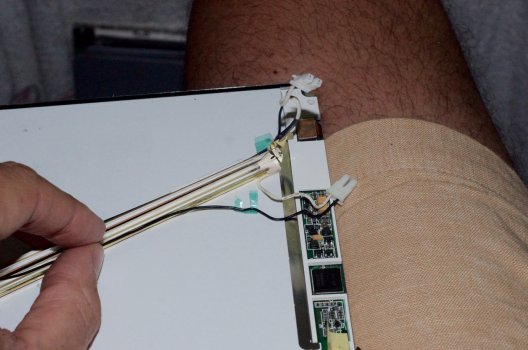
8. Lining them up I can see the original tube looks slightly thicker (maybe 2.5mm?) whereas the replacement is 2mm thick.
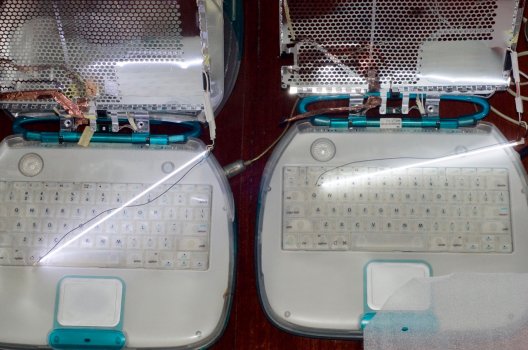
9. I did a bit of a "dry run" by dismantling the 'spares' iBook I mentioned earlier just to get an idea of what is involved. So here I hook up the two CCFL tubes side by side after carefully removing them from their reflective channels. It's impossible to tell here, but the original is the one on the right and the replacement is on the left. They both look bright in the photo, but the different was quite obvious in the flesh.
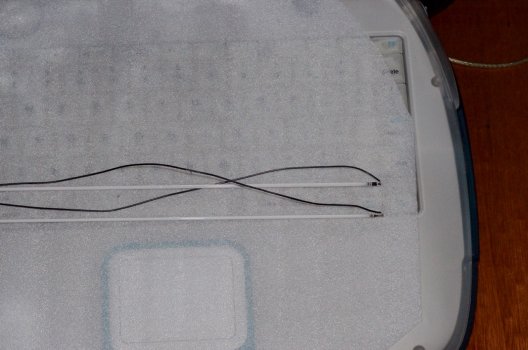
10. Here they are side by side. The top is the thicker, original tube.

11. Now this is where things get a bit questionable.. The original, thicker tube is about 4mm longer than the PBG4 12" tube. Is it going to work?
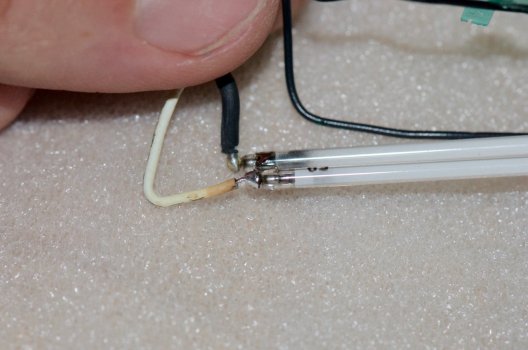
12. I decided to continue on anyway. The first step was to re-solder the connection of the white wire here so that it is straight on instead of being at a 90 degree angle. This will mean I can make up the difference in length by re-positioning the rubber end-caps.
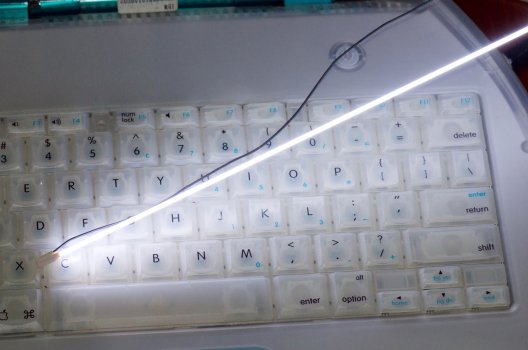
13. A quick test of the backlight after re-soldering and re-fitting the end caps. Looks good.
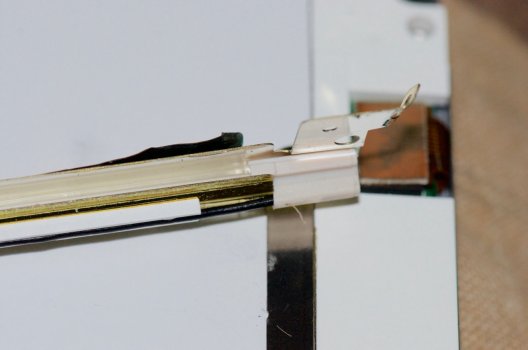
14. Here I've installed the thinner 2mm PBG4 12" CCFL tube into the original Clamshell reflective channel and positioned the black wire to run back along the channel in the white clips.

16. I've guided the black wire all the way along the channel, now out the other end (where the white cable and inverter plug are).
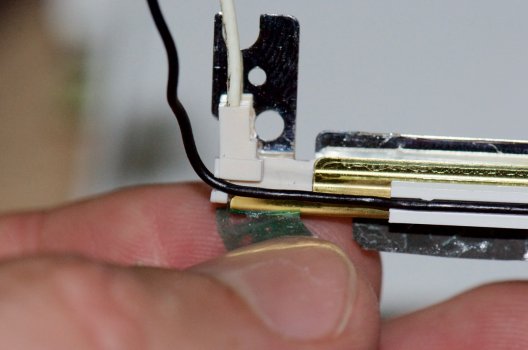
17. Here we are at the plug-end. I've re-attached the right-angle rubber end-cap here. I found it simpler to slice through this rubber cap to remove it from the original tube instead of removing the existing solder and re-soldering it back together. Once it is back together the cut along the rubber cap won't make a difference.
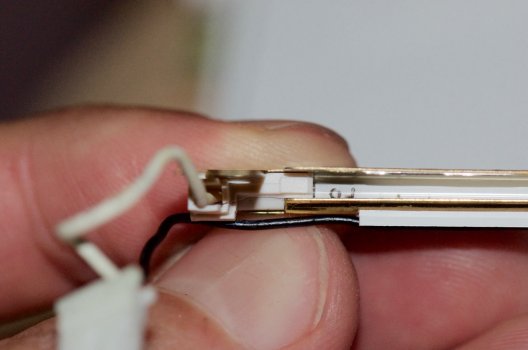
18. Now this is where a whole lot of patience and a little finesse came into play. I had to carefully position the shorter CCFL tube within the channel millimeter by millimeter until I had the ends barely visible. As with all fluorescent, the ends are never as bright as the rest of the tube.
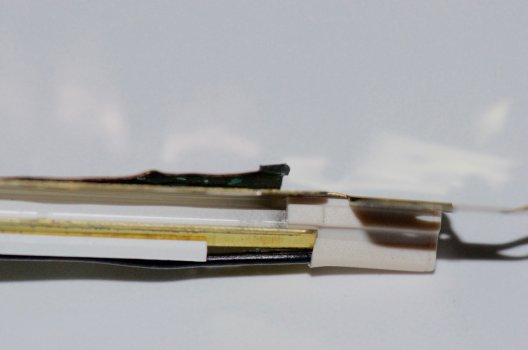
19. I've positioned the black wire end of the tube to be precisely within the end-caps. You can see the darkening of the CCFL tube which usually happens over time creeping into the corner.

20. I then installed the tube and reflective channel into the LCD panel. Initially it wouldn't sit very flush, so I seated things down with some Kapton tape here. The high-temps shouldn't affect the tape.

21. Here is the black-wire end after applying the tape. The original copper tape running along the top, which acts as a seal would not re-stick so I just taped it down from above. At this point I should mention that unlike EVERY other LCD panel I have worked on, the Clamshell has a backlight running along the top of the panel, instead of the bottom.

22. Here is a bit of a hack. Because the replacement tube had a shorter inverter cable, I had to re-wire the inverter plug behind the display housing instead of running in a channel down the right of the panel. Not sure if this is going to fit back together yet, but we will see...
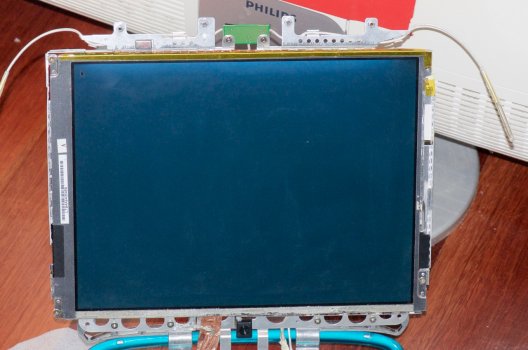
23. After fitting the CCFL tube I powered it up and the results are a bit disappointing...
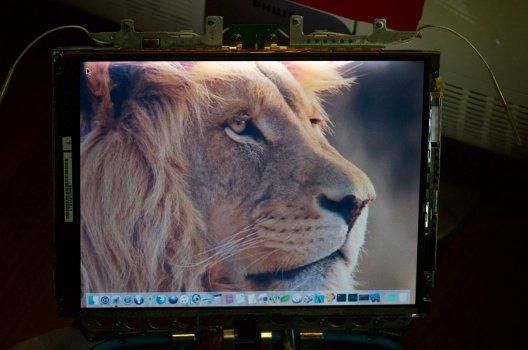
24. The top is super bright and the rest is dull as before...
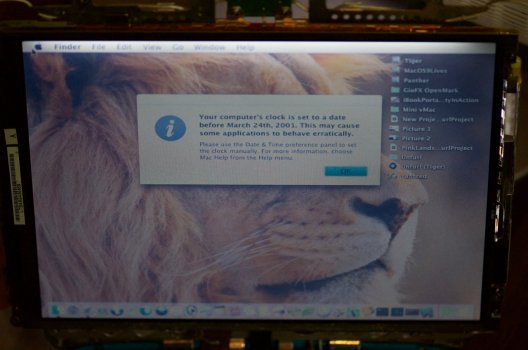
25. Yep, that is not going to cut it. Let's pull it all apart and do it all again. That initial resistance which I experienced from the channel when seated on top of the panel was because something was out of alignment. My guess is the reflective channel is facing forward by a few degrees instead of sitting perfectly flush with the panel.
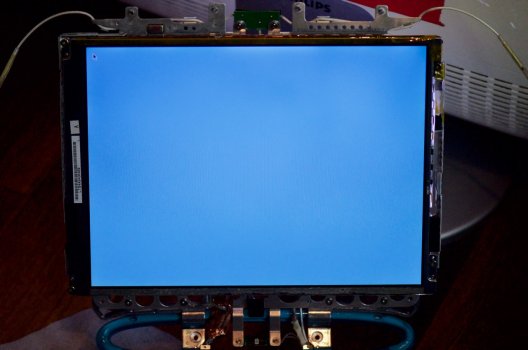
26. After disassembling the panel again, re-seating the backlight channel and re-assembling, the results are significantly better. I know, I can see some highlights in the photo here, but the difference is night and day.
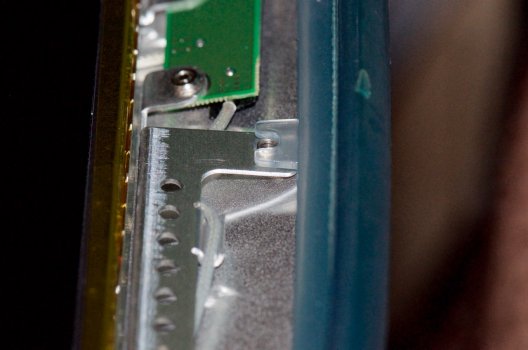
27. So, I began re-assembling the rear panel and front bezel... After getting it back together I noticed the rear housing felt loose, so I unclipped the plastic bezel and went at it again. I discovered that I had not hooked these plastic tabs in-front of the steel inner chassis so the 4 screws running along the top of the display were not connecting with anything.. Here I've hooked the plastic in front of the frame as it should be
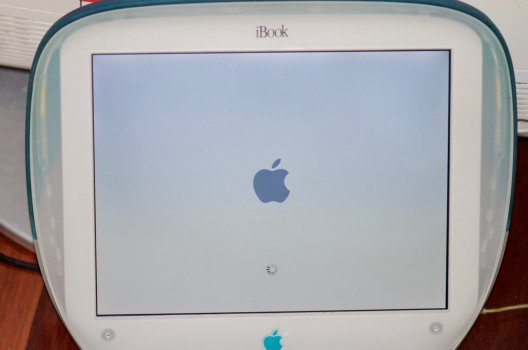
28. We are all back together now, so I boot it up. Looking good.

29. Gorgeous! We have full brightness and contrast, with just a minor darkness in the top right corner. This would be due to the slightly shorter length CCFL tube, but is certainly 1000% better than it was.
Overall I'd give the repair a 9 / 10. It cost me nothing and has restored the Clamshell display back to full brightness. I have no idea just how many hours that replacement tube would have had on it, but at least I now know that it is possible to replace the CCFL tube in the Clamshell with a 12-inch iBook G3, iBook G4 or PowerBook G4. It is not only possible, but relatively easy.
Success!
-AphoticD




